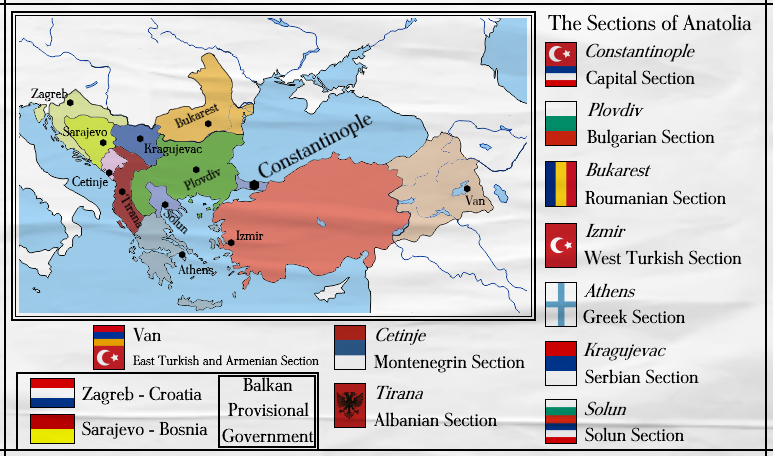HOME | DD
 ShootingSharkBOC — The Sections of Anatolia in 1936
ShootingSharkBOC — The Sections of Anatolia in 1936

#1930s #alternatehistory #balkans #bosnia #bulgaria #mapsandflags
Published: 2023-01-15 18:26:05 +0000 UTC; Views: 1005; Favourites: 9; Downloads: 3
Redirect to original
Description
After decades of political repression against the growing nationalism of the Balkan region in the early 19th century, aided by the remaining conservative powers of Western Europe, namely France and Britain, who are able to overcome their disdain towards the "sick man of Europe" through their much greater disdain for the now distinctively Eastern current of nationalism, revolt at last breaks out. Over the decades western influence in the Balkans begins to turn from help to hinderance, as what few liberals are left in Britain start to sympathise with the Greek cause and the more radical elements in the Bulgaro-Macedonian nationalist movement draw volunteers and funding from a radicalised late 19th century France, the 1910 Bulgarian revolt spearheaded by the People's Federative Party draws the support of left leaning factions in the Young Turk movement, and eventually brings about the collapse of the Ottoman government in 1912. Initially Anatolia Prope is left as it's own section, entirely under the control of the Young Turks, while the People's Federative Party reorganises the Balkans into an ethnofederal state, but the newly implemented Turkish nationalist policies inflames tensions in Eastern Anatolia with ethnic Armenians, Kurds and Lazi, and the Young turks quickly loose control of the East. In response the People's Federative Party steps in and organises Anatolia Proper along the Balkan model, with the exception of East Turkey as the only officially multinational Section in Anatolia.
Pictured also is the Balkan Provisional Government. After spreading Liberalism leads to the Bosnian Independence War in 1878-1882. Bosnian victory leads to the creation of a partially Liberal but largely non-secular republic, which comes into periodic conflict with it's Western neighbour, the Kingdom of Slavonia, a state stemming from the Partition of Austria in the Venetian Conference, before finally falling into outright war in 1917. After a brutal three year war in which ethnic and religious tensions play the greatest part, the League of Peace intervenes militarily and forms a provisional government in the region until tensions dissipate sufficiently for local governance to be deemed safe. This represents the first action on behalf of the League of Peace with real geopolitical consequences and is viewed as a success for modern democracy by much of the Liberal world.
Although lead by the socialist People's Federative Party, the Sections of Anatolia's relations with it's fellow Radical France are increasingly under strain as French volunteers join the Nihilist Serbian Cheta, a group formed initially as an anti-Ottoman militia but with aims more towards Nihilism, and federally irredentist or even seccesionist aims following the Bulgarian Revolt. As of 1936 the Cheta is made up primarily of former fighters in the Bulgarian revolt and the years preceding who became dissolutioned by the more moderate elements of Socialism and the lack of territority granted to the Serbian section relative to the Bulgarians. Together with French and Russian volunteers, they maintain effective control of much of Southern Serbia and bordering regions of Albania and Bulgaria, and have a reputation for acts of terror and excessive violence.
Another source of discontent in Anatolia are the Union Turks, a faction of the Committee of Freedom and Progress, the main descendant party of the Young Turk movement, which was and is more moderate than the left faction that pushed for a deal with the Bulgarians, and only aimed for constitutional monarchy. Now harbouring intimations of a single Turkish state, the Union Turks represent the main Restorationist and anti-federalist current of Anatolia.
Divided on religious, ethnic and political lines, many consider the continued existance of the Sections of Anatolia nothing short of miracle, and although the PFP maintians that the ethnofederal model can overcome this instability, whether this would remain true after the close of the Long Peace was very much an open question.
Map used as a base: d-maps.com/carte.php?num_car=4…
Map of Europe in this timeline: www.deviantart.com/shootingsha…
Questions welcome
























